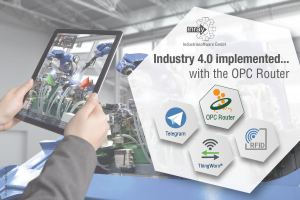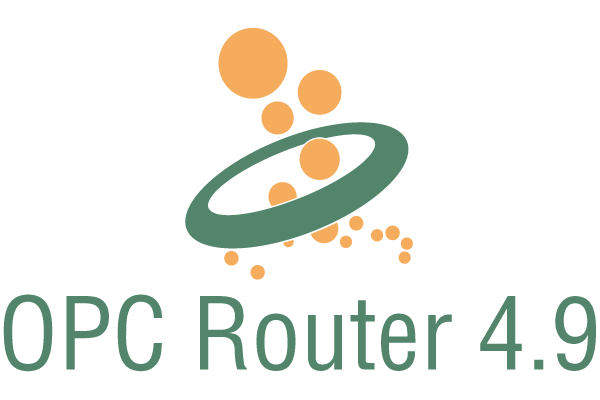OPC Router Release 4.9 – New Connectors for Industry 4.0
More Connectivity for RFID AutoID, Telegram Messenger and IoT Applications
The OPC Router Release 4.9 improves connectivity via Telegram Messenger for mobile devices – providing connection points for object identification and data control via RFID AutoID. The interface connection to ThingWorx puts versatile IoT connectivity at your fingertips, opening up connection possibilities for a wide scope of industrial Augmented Reality (AR) and IoT applications.

Industry 4.0 implemented with the OPC Router
The newly released plug-ins for the OPC Router mirror the growing demand for better connectivity solutions in the mobile device realm. Gaining mobile access to important data via the Telegram Messenger plug-in puts the plant manager or technician in the know quickly without having to access the information via a desktop PC in a fixed location. He can now be filled in on all production-related news via his smart phone and can move into action whenever he deems it necessary; for instance when an error alert is pushed to his phone or when performance reports of any given machine reveal deviations that need immediate attention. In order to connect to the IoT sphere, the new ThingWorx Plug-in provides the connection to the leading IoT Platform by PTC. The new plug-in ensures that the ThingWorx platform receives all the needed data and that it can also pass on information as data source. AutoID systems like barcodes and RFID tags and their respective RFID readers are well established in industrial environments – but only now the missing link has been provided for much higher compatibility between various devices and systems. With the RFID-AutoID (OPC UA) Plug-in diverse RFID applications can be planned and implemented.
Telegram Messenger: Mobile Industry 4.0 interface for smart phones
Telegram Bot
With the Telegram Messenger mobile access to industrial processes is possible, with user-specific data queries and activities – allowing fast responses in the event of a crisis or of exceptional circumstances, as well as regular everyday mobile access to production data at any given time and in any given location. Smart phones have been around for quite a while in various industries, as important and helpful smart devices in production environments. They can be used as in-house communications devices, set up to work entirely within secure networks. As smart mobile devices they can add extra flexibility to the work place in almost any production environment. This added flexibility corresponds with the modern notion of “anywhere, anytime, any device”, inherent in modern managerial concepts. Nowadays, mobile communication technologies are more and more seen to be helpful assets for production operations. The digital enhancement is not only advantageous in huge and spacious production halls but also for the technical operator or technician who isn’t anywhere near the production hall, when his interaction is needed. While off-site, the respective coworker can access important data when he needs it directly on his smart phone. The user can receive various push notifications, which contain all kinds of important information, such as alerts, production news or information about operating states. The OPC Router provided by inray permits configuration of multiple user profiles that far extend the scope of basic text messages. Besides push notifications, actions can be prompted via the Telegram Bot as well. Users need to be authenticated, which ensures that only authorized users can access certain data via their smart phones.
Industry 4.0 and Mobile Communications are a perfect fit when facilitated by the Telegram Messenger. The Telegram Messenger Plug-in for the OPC Router connects any data anywhere with the mobile world. Production operations can now be much more agile and smart – by adding mobile communications to a smart factory environment.
RFID AutoID: Fully deployable RFID technology
RFID AutoID OPC UA
With RFID AutoID automatic identification and automated data acquisition are even more capable – because the RFID AutoID function can be used independently of manufacturer-specific protocols and connection types. The OPC UA AutoID Companion Specification brings about this new interface independence. The specification contains all the basic programming groundwork that is needed to get connected easily, obliterating time-consuming and cumbersome programming tasks. RFID AutoID can be deployed everywhere because the OPC UA protocol permits fast accessibility to modern technologies, systems, machines and devices – as long as the connection is made via an OPC UA-capable client – like the OPC Router provided by inray – with the ability to interpret the OPC UA AutoID Companion Specification. The advantages of the automatic identification system RFID AutoID are its agile and mobile practicability. All movables can be identified with any OPC UA-compatible RFID Reader. An RFID transponder or RFID tag must be attached to the respective moveable object to make automatic identification happen in an instant. With increased transparency, an increase of application possibilities in production spur on more efficient and increasingly holistic production planning and control processes both in production and in manufacturing logistics. The use of RFID transponders is not limited to only a few use cases anymore. With AutoID, tracking can become a part of an holistic operative business concept. RFID transponders are not only helpful for identifying and tracking objects but are also important for unlocking additional data that is associated with any given object via the object’s ID. Thus, associated product data or data that is produced at any given point throughout the manufacturing process, can be retrieved.
Industry 4.0 und Wireless Identification are a perfect fit in connection with RFID AutoID. With the RFID-Auto ID (OPC UA) plug-in the OPC Router provides the required interface to AutoID-ready RFID readers and any modern backend systems, respectively.
Related Information:
Harting and Siemens offer AutoID-ready RFID readers that help make Industry 4.0 production more fully deployable with wireless identification.
ThingWorx: IoT and Augmented Reality technology encounter Industry 4.0
ThingWorx
With the IoT Platform ThingWorx any machine can be represented as digital twin – which allows visualization of machines by employing AR technology. In order to represent and thus depict reality in any given virtual space an IoT platform is required that can make data both available and retrievable at lightning speed. Complex software applications require high data volume for graphical depictions, for instance as Augmented (AR) or Mixed Reality (MR). Depending on the use case, digital representations of devices, machines or sensors are generated and can be sent to head-mounted VR displays that exclude the outer surroundings or into any desired surrounding via hologram technology, which then includes that specific real-life location. In order to make this work, a digital representation of the machine is created in the virtual space. Visual information applications might only provide the depiction of simple images, technical drawings or diverse animated CAD-visualizations – but could also offer an exact digital replica of the material machine or of any other technical instrument in the digital space. If visually guided interaction (also known as image-guided interaction) in the virtual space is required for actions performed on the real machine, the digital representation and control of the respective real-time interaction must be secured by powerful servers.
The API connection has to be established via a powerful client – like the OPC Router provided by inray (www.inray.de/en) – to facilitate data integration with highly complex IoT applications via an IoT-ready platform. Once this is established, data can be sent and retrieved to allow concrete work in the digital space in a variety of ways but always pertaining to the rendered digital twin.
Industry 4.0 and Augmented Reality Technologies are a perfect fit when facilitated by the IoT Platform ThingWorx. The ThingWorx Plugin of the OPC Router provides the interface to connect to the Internet of Things (IoT). Thus opening up many ways to implement digital visualizations – besides other equally technologically inspiring IoT application scenarios.
Additional related information:
Product information and freely available download link to run an OPC Router test: OPC Router

